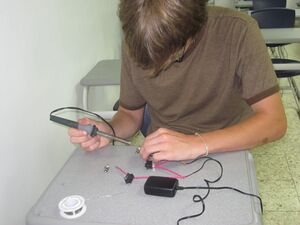
The purpose of this electricity module is to create a portable and inexpensive tool to teach students about circuits in parallel and in series, the two simplest ways to connect a circuit. This knowledge can then be applied to a variety of renewable energy projects. Two or more boxes are constructed to demonstrate how series and parallel circuits interact. Students apply Ohm's law to calculate the flowing current at any section in the circuit with the voltage and resistance.
Ohm's Law where:
Materials[edit | edit source]
-
Materials for construction
| Material | Quantity | Total Price |
|---|---|---|
| Wire/Alambre | 20 ft | $67 (RD) / $1.67 (US) |
| Scissors/Tijeras | 1 | $75 (RD) / $2.00 (US) |
| Glue/Cola | 1 | $80 (RD)/ $2.10 (US) |
| Light Bulbs/Bombillas | 10 | $500 (RD) / $13.15 (US) |
| Switches | 10 | $100 (RD) / $2.63 |
| Soldering Iron/Soldador | 1 | Donated/Donado |
| Solder/Soldadura | 1.5 oz | Donated/Donado |
| Cell Phone Charger/Cargador | 2 | Donated/Donado |
| Cardboard Box | 1 | Donated/Donado |
| Tape/Cinta | 1 | Donated/Donado |
Construction[edit | edit source]
- How to Build Step by Step
-
First draw out a schematic for the first circuit.
-
Draw out a schematic for the second circuit.
-
Cut the end of the charger cord off and strip about 1/2" of wire. This will serve as the transformer.
-
Strip wire ends and connect bulbs and switches as drawn out in schematic.
-
Test use circuit before soldering by plugging the transformer into the wall and turning all switches on.
-
After circuit has been verified complete start soldering wires together.
-
Once soldered hide circuit under box with light bulbs on top
Learning Activity[edit | edit source]
In small groups, students turn switches on and off noting which bulbs turn off and which bulbs become dimmer or brighter. Then students hypothesize which circuits are in parallel and which are in series.











